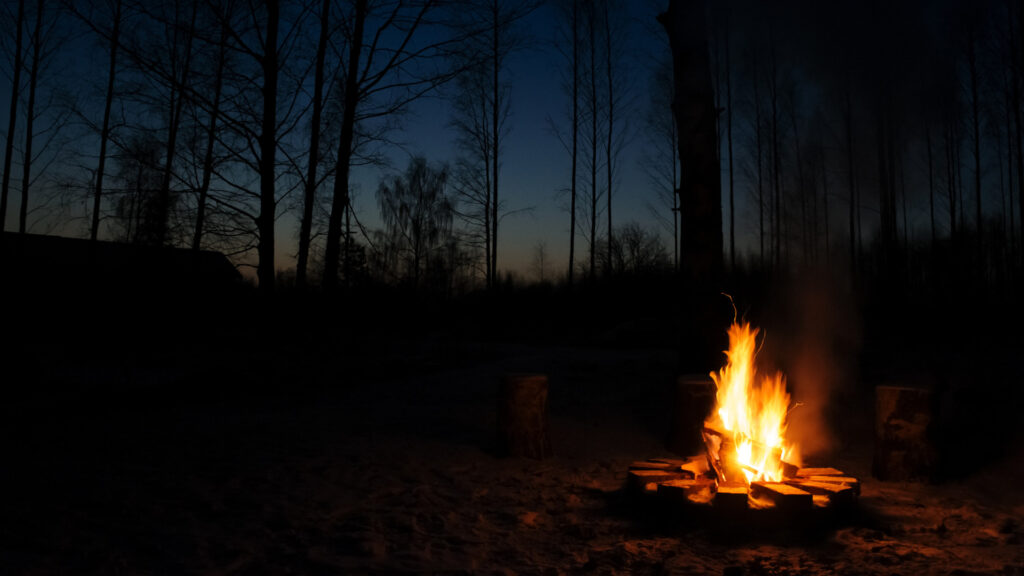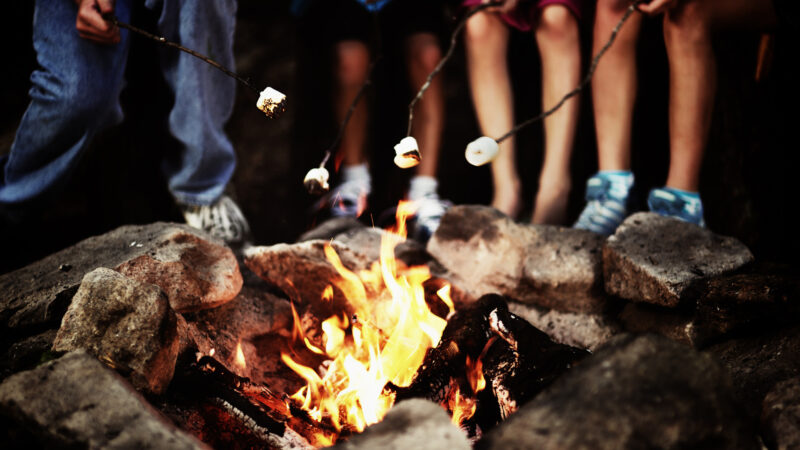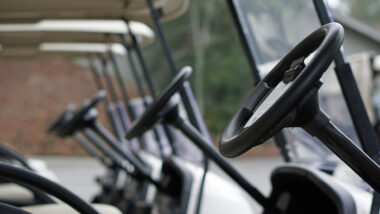Table of Contents Show
If you plan to spend a lot of time camping, you better know how to make a campfire. There’s no better way to create priceless memories with your loved ones than by gathering around a fire.
However, even if you’ve been building campfires for years, there’s a chance you could be doing it wrong. You must follow a handful of rules every time you make one.
Today, we’ll share five rules worth following when building the perfect campfire. Let’s get started!
Why Is a Campfire Important When Camping?
A campfire is crucial when camping for several reasons. First, a campfire can provide a source of heat when camping in cold weather.
Pulling your camping chair up as close as safely possible to the fire can prevent you from shivering through your entire camping trip.
In addition, because a campfire can create so much heat, it’s also helpful in cooking food. While no scientific data supports our claim, food tastes better after cooking over a campfire.
With the right tools and ingredients, you can cook more than hot dogs.
Finally, campfires are essential when camping because they can serve as a gathering place for you and your fellow campers. Campfires create the perfect atmosphere for people to gather and enjoy each other’s company.
Some of the most cherished memories for many campers involve sitting around a campfire with their friends and family.
What Is the Best Wood for a Campfire?
To make the perfect campfire, you need to know that some wood is better than others. Hardwoods like oak, hickory, and maple are the best wood for a campfire.
These are great for campfires because they tend to burn very hot and slowly. It doesn’t get much better than a campfire that burns hotter for longer.
In addition to hardwoods, you want to use wood that has had time to dry thoroughly. Seasoned firewood has been cut and split long enough that all of the moisture in the wood has evaporated or dried.
If you try to use freshly-cut wood for your fire, you will likely end up with a smoky fire that struggles to stay lit or produce any meaningful amount of heat. The best wood for a campfire takes six to 12 months to dry completely.
When Should You Not Make a Campfire?
When camping during the dry season or drought conditions, you’ll likely want to think twice about making a campfire.
Dry conditions can cause the grass and other vegetation in the area to become potential fuel sources. A stray spark or ember can cause a wildfire that can spread incredibly fast.
If you’re camping during drought-like conditions, local authorities could enforce a burn ban. While many campgrounds provide plenty of warning, some boondocking and other dispersed camping locations may not.
It’s your responsibility to know the rules and regulations where you’re camping.
Violating a burn ban by having a campfire can be a costly mistake. Violators can face fines upwards of $5,000 for the offense. So familiarize yourself with the rules and regulations when camping.
When in doubt, chat with officials at the campground or call the local agency managing the public lands.

5 Rules for Building the Perfect Campfire
Here are a few essential rules you must follow to build the perfect campfire. If you do, you’ll stay safe and have a roaring fire to enjoy during your trip. Let’s get started!
1. Always Use a Fire Ring
A fire ring is effective at containing a campfire in a particular area. Many established campgrounds provide metal fire rings at each campsite to help keep campfires under control.
However, if you’re camping in a remote wilderness location, there’s not likely a fancy metal fire ring. In these cases, you’ll need to make your own.
Making a fire ring is relatively easy, but it will require effort. The best way to do this is to gather as many large stones and rocks as possible. You’ll want enough to create a circle large enough for your campfire.
Place the stones next to each other to make the circle and fill the gaps with smaller stones. You want to create a good enough barrier that fire isn’t likely to escape.
2. Gather The Proper Materials
One of the most critical factors in building the perfect campfire is having suitable materials. You’ll need plenty of kindling. Kindling is the small pieces of sticks, twigs, and other soft and dry materials that burn easily.
In addition, you’ll need enough dried firewood to keep your fire burning as long he necessary.
You want to be careful about bringing firewood or traveling too far with wood, as this is how invasive species and dangerous wood diseases appear in an area. Some campgrounds require campers only to use locally-sourced firewood.
Lastly, you’ll want a fire starter. Whether using a lighter or attempting a more primitive method with a striker, you’ll need something to ignite your fire.
You can find fire starter materials that burn extremely hot for a considerable time to ensure your firewood catches a flame. When you use them properly, you can have a blazing fire in minutes.

3. Use the Right Technique
It’s best to start with a generous amount of tinder and kindling when starting a campfire.
Blow softly but consistently on the fuel and kindling to feed the flame with oxygen. You’ll notice that the fire begins to spread and grow quickly.
There are several methods for building a campfire, including the teepee, the lean-to, and the log cabin.
While they all serve the same purpose, how you place the wood can matter when effectively starting a campfire. You can’t toss the wood into a pile and expect it to ignite easily.
Pro Tip: These Campfire Starter Kits have everything you need, not only to start a fire but to keep it going too!
4. Keep It Fed
If you want your fire to stay going, you’ll need to add more fuel. This is why you must have plenty of firewood for your camping trip. You don’t want to run low on firewood, especially if you depend on your fire as a heat source or for cooking.
Some areas will allow you to burn downed trees and limbs. However, not every site allows campers to do this. Check the rules and regulations where you’re camping before you gather firewood.
You could land yourself in hot water with the park officials if they do not allow campers to collect firewood in the park.

5. Have a Bucket & Shovel Nearby
Campfires can get out of hand very quickly. As a result, many experienced campers keep a bucket of water and a shovel on hand.
This helps ensure that a camp can quickly respond if a spark from the campfire ignites the grass or surrounding landscape. Splashing water or digging up dirt to throw on the tiny flame can help prevent it from spreading into a much more dangerous situation.
How Do You Put Out a Campfire for the Night?
Never leave your campfire alone when it’s time to retire for the night. Fully extinguish your campfire and eliminate any remaining hot coals. While water is very effective at extinguishing a campfire, using too much can flood your fire pit.
Use a shovel or stick to stir and mix the coals thoroughly. You’ll notice that the coals quickly cool down as you stir them.
Focus on getting an inch or two into the ground and stir up some coolest dirt and ash to mix with the hot coals. They’re still hot enough to be dangerous if you can see glowing coals.
Keep in Mind: You may not plan to arrive to your campsite late, but life happens! Be prepared with our Tips for a Late-Night Arrival at the Campground!

Gather Around the Perfect Campfire
Building the perfect campfire is a skill that takes time to develop. Take your time and set yourself up for success by having the proper materials and quality wood. The more you can practice building a campfire, the easier it becomes.
So if you’re looking for an excuse to take a camping trip or to start a campfire in your backyard, now you have one. Tell your loved ones you need to hone your campfire-building skills.
If they’re not convinced, pull out the marshmallows and other s’more supplies, and that should do the trick.
Are there any campfire bans or regulations in your area?






